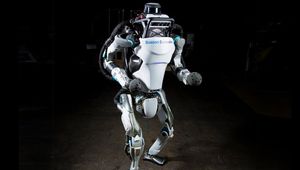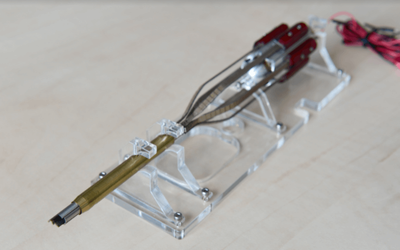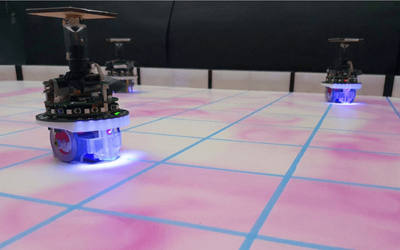Open-Source Vacuum Oven for Low-Temperature Drying
A small-scale, open-source vacuum oven design for low-temperature drying
Technical Specifications
| Vacuum Chamber | off-the-shelf vacuum chamber; 98 kPa |
| Diameter: 200mm | |
| Height: 200mm | |
| Fixed-Flow Air-Powered Vacuum Pump | practical limit absolute pressure: 6.7 kPa |
| Saturation temperature: below 40 C | |
| Insulation | Reflectix Double Sided insulation |
| Size: 10 sq ft | |
| Vacuum Gauge | with rubber hose |
| Vacuum Pump Intake Connector & Vacuum Connector | 3-D Printed |
| Thermal Control System | 120 V Silicone Heating Pad |
| Size: 100 mm x 125 mm | |
| Power: 1.16 W/cm2 | |
| Sensor | Negative-temperature-coefficient (NTC) Thermistor |
| Precision: 0.2 C | |
| Solid State Relay | Input: 5 V |
| Output: 120 VAC/2 A+ | |
| Microcontroller | Arduino Nano |
Overview
This tech spec was submitted by Joshua Pearce as part of the University Technology Exposure Program.
Problem / Solution
Dehydration is a vital phase in the materials process that affects many different sectors. It includes taking the water out of a material or system. Due to its affordability and effectiveness, most sectors now use vacuum drying to dehydrate materials while protecting them from thermal deterioration. However, small-scale vacuum drying technologies are currently limited. Food, wood, and plastic can all be dried using hot-air dryers like food dehydrators, toaster ovens, and standard convection ovens. There are more sophisticated and expensive dehydration methods, such as vacuum ovens and freeze dryers.
This small-scale, open-source vacuum oven is designed utilizing readily available components and those that were 3-D printed. This oven is used to quickly dry material in a vacuum at a high (but relatively low) temperature. Its main function is chemical processing, dry plastic for distributed recycling and additive manufacturing, and dehydrating biological organisms. Compared to hot-air dryers, the open-source vacuum oven can dry plastic and biomaterials efficiently. The technology is tested for drying speed and effectiveness on waste plastic polyethylene terephthalate (PET), and a consortium of bacteria developed for bioprocessing of terephthalate wastes. Vacuum drying is a good option since damage happens when both materials are exposed to high temperatures.
Design
The vacuum oven is equipped with an off-the-shelf vacuum chamber, a vacuum pump powered by compressed air, and a thermal control system for heating samples inside the oven developed around an Arduino microcontroller platform. A heating element and vacuum chamber make up the vacuum oven. Multimeters and an open-source precision mass balance are being used to monitor the process.
Vacuum System
The vacuum system includes a ready-made 200mm × 200mm physical vacuum chamber with enough room for drying and the ability to withstand vacuum pressures of up to 98 kPa (29 inHg). The readings are expressed in kPa, where "absolute," "gauge," or "vacuum" are indicated. The system's vacuum pump, an air ejector, was selected because it is powered by compressed air and can generate vacuum pressure using a combination of converging-diverging nozzles and high-pressure air. The air ejector is also chosen based on its effectiveness and durability. The size and form of this nozzle are also determined by the required inlet pressure, rate of evacuation, amount of air used by the ejector, and depth of volume. The practical limit of a single-stage air ejector is 6.7 kPa (absolute pressure), and a water saturation temperature of below 40 C. Water or other objects getting caught up in the passage of evacuated air cannot damage the vacuum system. Since compressed air is used in a variety of industrial operations, implementing a vacuum system is more affordable in this setting. Additionally, small labs utilize air compressors more than mechanical vacuum pumps.
Thermal Controls
The technology's thermal control system is built with a heater, relay, and microcontroller. The microcontroller uses a thermistor with a negative temperature coefficient (NTC) to measure the heating pad's temperature. The measurement accuracy depends on the model's accuracy, the temperature range, and the resolution of the analog-to-digital converter. A typical thermistor sensor used in 3-D printing produces measurements with a precision of 0.2 C. Using an Arduino microprocessor and a voltage divider, the thermistor's resistance is assessed, and the temperature is estimated from the observed resistance (vice versa).
The model is often accurate to within 0.5°C over the calibration range, but it is condensed to a two-point model that only needs a single coefficient and beta coefficient. Across a smaller temperature range, the simpler model maintains a similar level of accuracy. Due to its pre-made components, building a reliable temperature management system is challenging. Conduction is the principal route of heat transmission used by the model. Still, it can be difficult to incorporate because it depends on various elements, including the kind, volume, density, and surface area of the material inside. A 100mm x 125mm flexible silicone heating element is used as an engine block heater to prevent damage to the chamber.
Additionally, the controller operates under the presumption that there is enough insulation and time for equilibrium to be reached. The gradient is measured using loosely packed rPET, allowing the operators to calculate the temperature differential between the heater and the chamber. To compensate for the temperature differential, the measurements will be utilized to set the oven's temperature. Additionally, the method stated is suitable for small samples. Importantly, the technology is equipped with a straightforward relay control system that regulates the heater's temperature and allows the thick metal of the chamber to properly block the relay's switching effect, generating a stable temperature curve inside the chamber.
Performance
The system can more quickly and efficiently dry recycled plastic and biomaterials than a hot-air dryer sample. The vacuum oven can also be produced for under $360, or around 20% of the cost of the industrial vacuum drier. The technology can also be used for various scientific tasks such as chemical processing, drying plastic for DRAM, and dehydrating microorganisms. Laboratory samples weighing 10g can be dried in the vacuum oven in 75 minutes, while bigger samples need roughly 3 hours to dry. A range of 0.12 kWh/g for big amounts to 1.55 kWh/g for tiny amounts of rPET is measured when running at lower temperatures, while the specific energy required to dry biomass is 1.17 kWh/g.
References
A research paper describing the challenge, design, and outcome of the research.








